This post may contain affiliate links. Read our disclosure policy.

Butter or shortening? It’s a debate I’ve heard among many bakers and even within the comments of my blog so I decided to tackle another round of baking experiments. Recently Clabber Girl challenged me to use their baking powder in a series of posts all about biscuits throughout the rest of the year. What better subject for baking experimentation? Also, how cool is my job? To kick off this month’s biscuit post I’m experimenting with one of the most important ingredients of the biscuit and that’s the fat. We wanted to find out which fat is better for making the perfect biscuit: butter or shortening?
I wanted to go beyond showing you how to make biscuits and help you understand how the ingredients impact your final product. It seems so simple to just substitute out one ingredient with another but baking is truly a science and every change you make can result in a totally different product! Keep reading to find out how butter and shortening impact everything from the dough, appearance, taste, and texture of your typical buttermilk biscuits and to find out which was my favorite!
Be sure to follow Clabber Girl on Facebook for tons of baking recipes and tips and stay tuned for more posts all about biscuits!
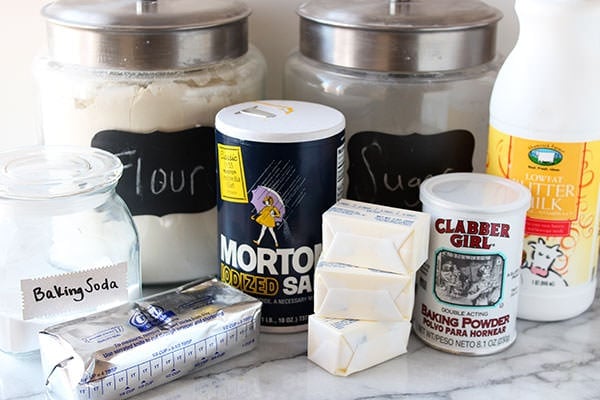
Perhaps the best aspect of homemade biscuits is just how simple they are with just a handful of staple ingredients and a few steps. I’ll never understand how those processed canned biscuits became so popular since biscuit dough takes just minutes to whip up! Sure, you’ll have a few more dishes to clean but there’s nothing that compares to the unadulterated goodness of a homemade biscuit.
To experiment with butter versus shortening, I used the standard biscuit recipe (below), which is my go-to. I used the same techniques, ingredients (except the fat of course), baking times and temperatures to ensure consistency between the two batches.
All Butter Dough
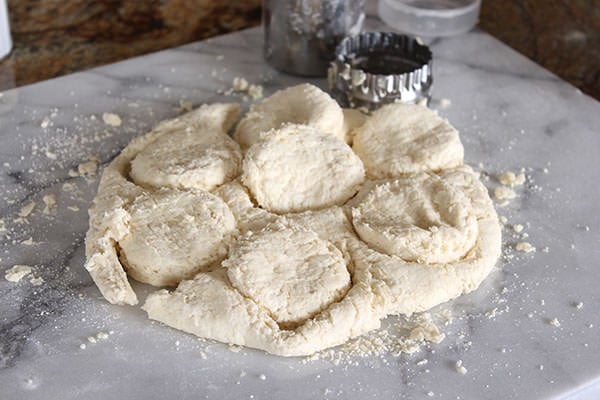
The all-butter dough was slightly less cohesive than the all-shortening dough, and I attribute this to the fact that the butter’s texture is firmer than shortening. Even when both fats were chilled in the same freezer for the same length of time, the butter was significantly more solid which made it easier to retain chunks of butter while mixing the dough.
The cold chunks of butter are important because as they melt into the biscuit while baking they create tiny pockets of steam that puffs and lifts the dough. These pockets turn into that beautiful light and flaky texture we crave with biscuits. The steam comes from butter’s water content, which is usually about 15 to 20 percent.
Those chunks of butter, while as glorious as they become while baking, do make the dough a little loose and slightly difficult to work with. Not to mention butter’s low melting point makes it more difficult to work with as it needs to be cautiously kept cold.
Shortening Dough
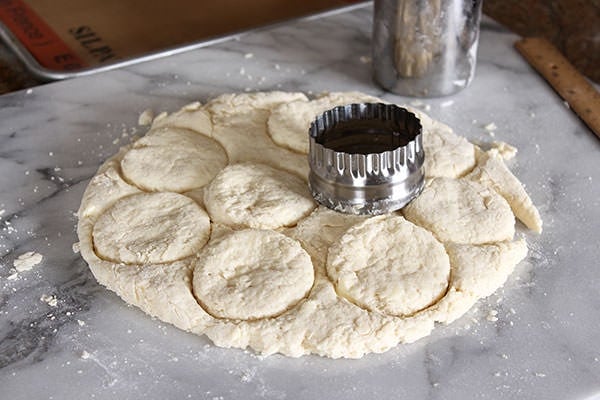
The shortening dough, on the other hand, came together much more easily. In fact, it came together almost too much. If you overwork biscuit dough you run the risk of getting tough and dense biscuits. With the shortening being so sticky itself, even when chilled, it made it hard to retain any sort of looseness in the dough. Instead, it all came together in a slightly sticky, shaggy mass.
This doesn’t matter as much as it does with the all-butter dough, however. Where butter is only about 80 percent fat and the rest is milk and water, shortening is 100 percent fat. There is no steam created in shortening dough that lends the same light, airy flakiness as with butter dough. While the shortening dough was nicely cohesive, the stickiness made it difficult to roll out and shape.
Any type of biscuit dough, or even pie dough which is very similar, is going to be more difficult to work with than a soft, smooth, and supple yeast dough. The pay off, however, is that it only takes about a half hour to make biscuits from start to finish!
Baking the Biscuits
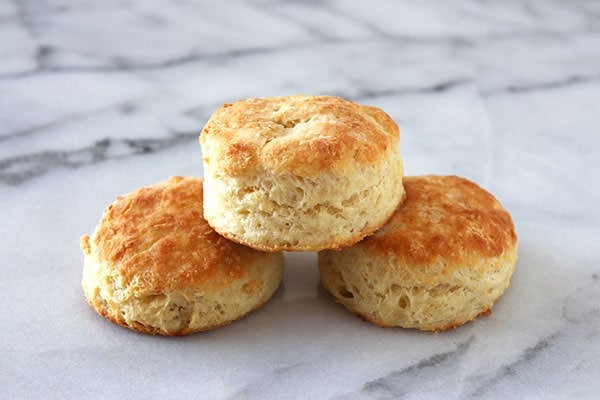
So, what happened when the biscuits came out of the oven? Well, upon first glance the butter biscuits were significantly more browned with flatter tops. When bitten into, the butter biscuits were moist and slightly spongier than the shortening biscuits. The best part was the flavor and slightly more crunchy exterior texture contrasted by that ultra tender interior.
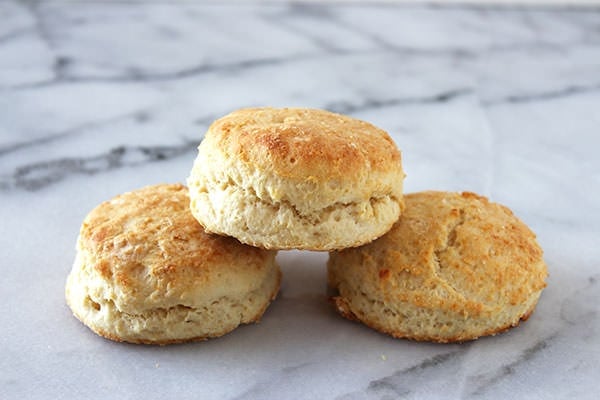
The shortening biscuits were much more pale, with slightly domed craggy tops. They also seemed a bit more irregular in height. The biscuits themselves were more crumbly when bitten into and lacked that characteristic butter flavor that simply cannot be replicated by anything artificial.
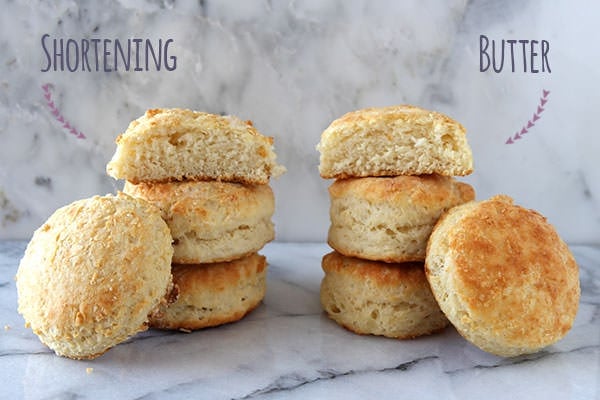
I offered two biscuits to Jared and made him guess which was butter and which was shortening and he got it right. You can definitely taste the difference and as a butter lover, I definitely preferred the butter biscuits. However, the shortening biscuits did remind me of biscuits I’ve had at Southern eateries in the past with their slightly drier, crumblier texture.
Since shortening has a higher melting point than butter, meaning it requires more heat to melt shortening than it does to melt butter, it makes shortening less challenging to work with. You don’t have to worry as much about it getting too warm in the dough and it brings together the dough more easily. However, that higher melting point can also be a very bad thing because it means that it doesn’t fully melt in the mouth like butter does, leaving behind an unpleasant waxy coating on the palate.
So what’s the final verdict?
Butter is the winner here. The butter biscuits were moister with that wonderful butter taste and melt-in-your mouth texture. I’d be curious to test out substituting half or just two tablespoons of the butter with shortening to see if you get the best of both.
Have you experimented with that? What do you prefer to use in your biscuits?
Like this post? Share it on Pinterest!
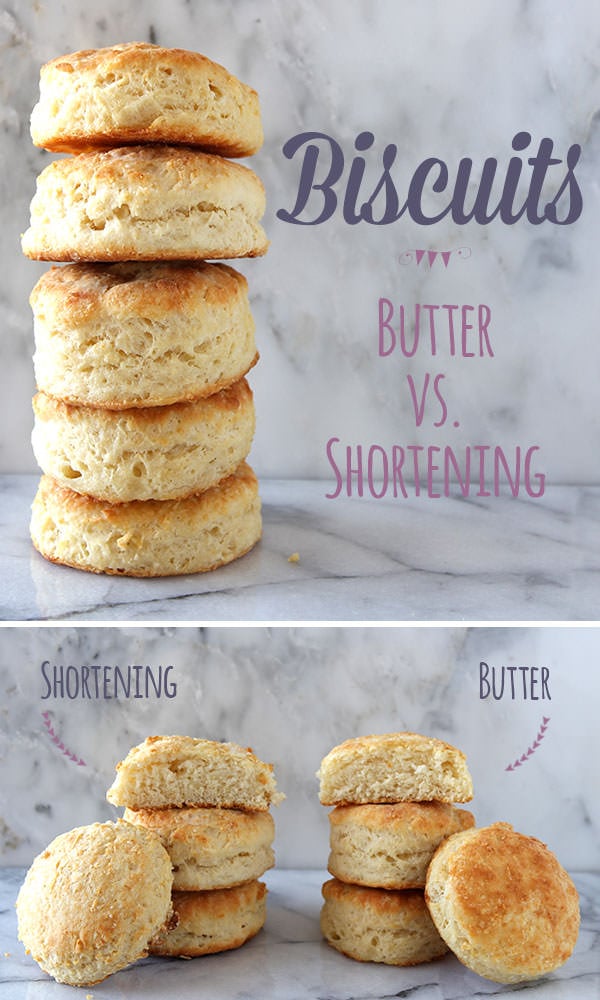
This post is sponsored by Clabber Girl. All opinions provided are my own.
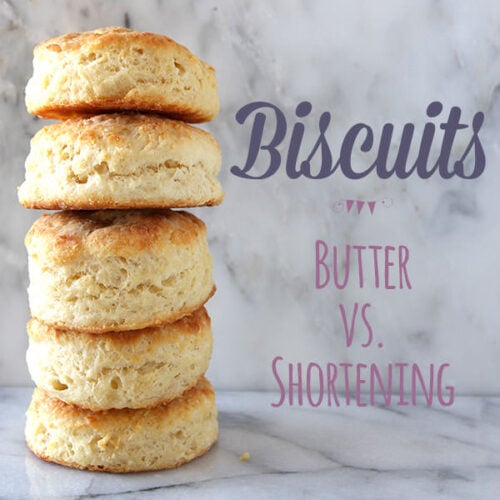
Biscuit Recipe
Ingredients
- 2 cups (9 ounces) all-purpose flour, plus more for dusting
- 2 teaspoons granulated sugar
- 1 tablespoon Clabber Girl baking powder
- 1/4 teaspoon baking soda
- 1 teaspoon fine salt
- 6 tablespoons unsalted butter OR vegetable shortening, very cold
- 1 cup buttermilk, chilled
Instructions
- Preheat the oven to 450°F. Line a large baking sheet with parchment paper.
- In the bowl of a food processor, combine the flour, sugar, baking powder, baking soda and salt. Add the butter or the shortening and pulse the food processor several times to cut the fat into the flour until the mixture resembles coarse meal. You can also do this by hand with a pastry blender. The faster you do this the better, you want the fat to remain cold. Stir in the buttermilk until just combined. DO NOT overmix, the dough will be slightly sticky.
- Turn the dough out onto a floured surface and dust the dough with flour. Gently pat the dough out until it’s a 1/2-inch in thickness. Use a 2-inch round biscuit cutter to push straight down through the dough to cut out circles, try not to twist the cutter. Place the biscuits on the baking sheet, spacing 2-inches apart. Reform the scrap dough into 1/2-inch thickness, being sure to work with it as little as possible, before cutting out more circles. You should get 10 to 12 biscuits.
- Bake the biscuits until golden brown, about 12 to 15 minutes.


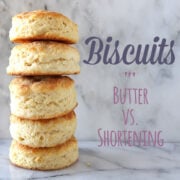
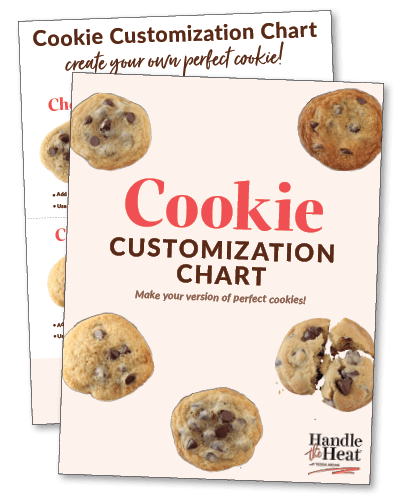
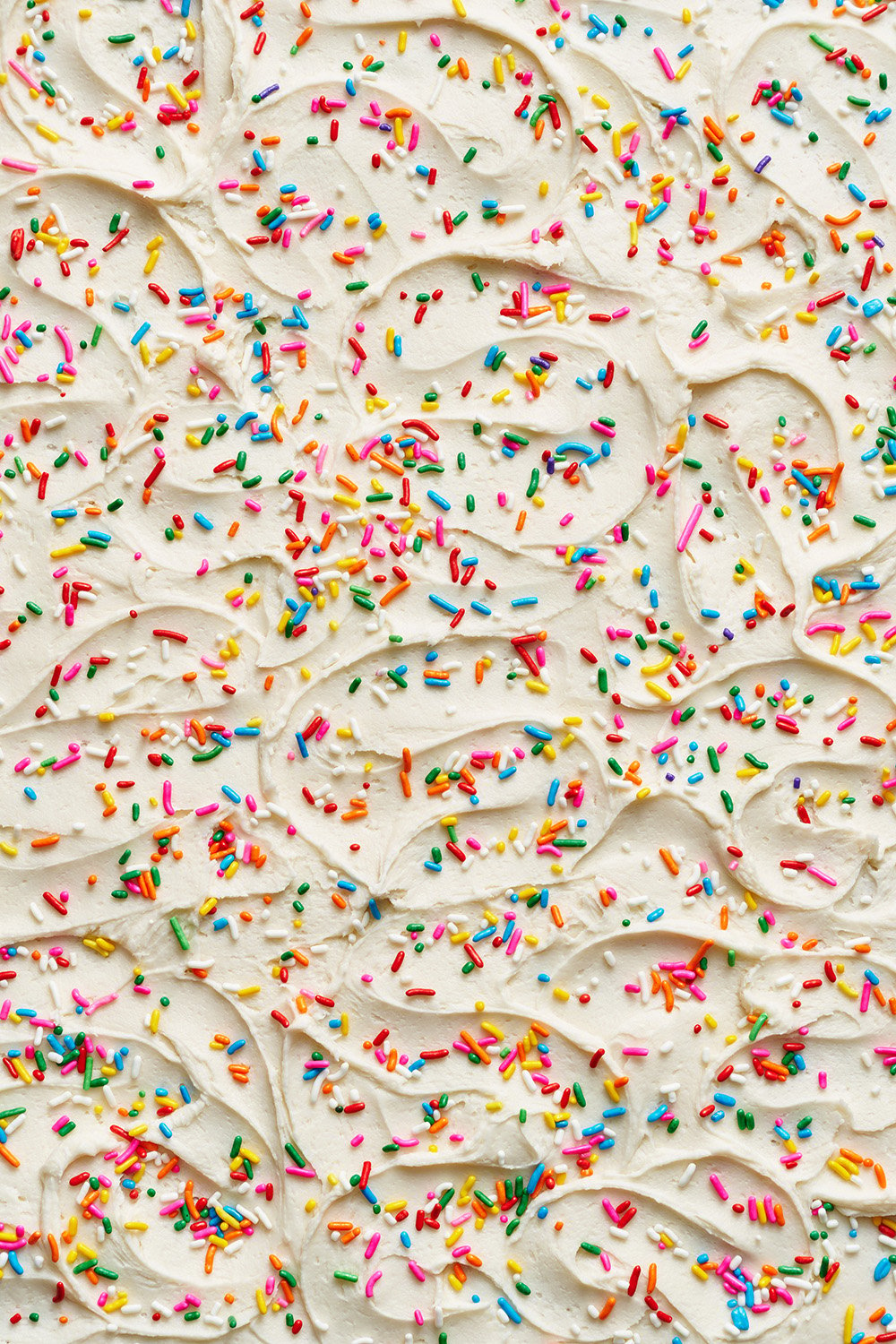


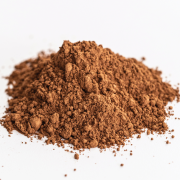
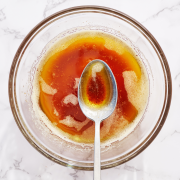
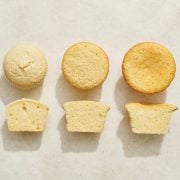
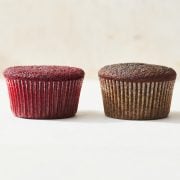
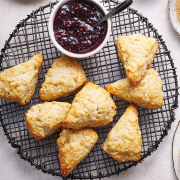
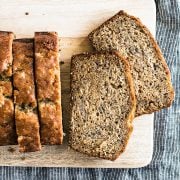
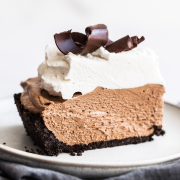
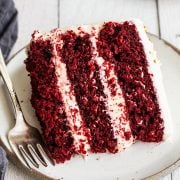








Just tried these tonite. Terrible failure here.
Your recipe reads 2 cups (9 ounces) flour…. what exactly does that even mean? Or, is this supposed to be weight?
I made with 2 cups flour and this had consistency of pancake batter.
Tried this wonderful recipe with butter and they were amazing, family loved them, soft, fluffy, and buttery tasting.
This turned into a soupy DISASTER. 2 cups a flour and 1 cup of buttermilk? Seriously? I ended up using close to 5 cups of flour just to make 10 biscuits.
When I was 10 (60 years ago) my mother taught me how to make biscuits. I made biscuits for dinner every night. The only fat we had then was lard and my small fingers probably helped incorporating the lard into the flour. My biscuits always came out tall, taller than any I’ve ever made since then.
Tried these this morning and they didn’t rise … hardly at all. What could I have done wrong? I was very careful now t to overwork the dough, it was barely keeping together.
hm! Is your baking powder fresh? The dough will need some working to come together, but once it does that’s when it’s important not to overwork it.
I’ve been on a quest to find the best biscuit recipe & my favorite, so far, is a recipe that uses butter and shortening – equally. When I say my favorite, so far, I mean that I love the taste of these biscuits, but I’m not a fan of how crumbly they are & of how they don’t rise as much as I’d like. Thank you for your research & I will try your recipe. I may end up sticking with what one of your readers stated her mom does & that is using 3/4 butter & 1/4 shortening. On to trying your recipe first. Thanks for everyone’s comments. I’ll be back with an update on my findings. Thanks!!!.
Wish your recipe and article was the 1st on google because it’s wonderful and most of the others are terrible. Thank you!!!
Did you use vegetable shortening or lard? Lard makes heavenly biscuits. It gives a lightness, Its high smoke point allows higher temps, providing a different texture. I also make biscuits with butter. Have made suprerme biscuits with coconut oil and quite good with olive oil. I do a mixture of butter and crime cheese for use in strawberry shortcake.
Southerners generally prefer self-rising. White Lily used to be absolute best flour, but the brand was bought by a big flour maker and production moved to another plant and now it performs about like the big brand, I don’t recall whether it was Fold Seal or Pillsbury or another. Martha White Hot Rize still is superb.
in days long past, I think self-rising had a different leavening chemical that resulted in spongier biscuits, and perhaps some still do. But a lot of self-rising nowsimply has what you’d add to plain.
I’ve seen recipes for beer biscuits or even 7-up, with the tiny escaping carbonation bubbles providing lightness you describe in butter biscuits. Has anyone tried them?
In
Would using clarified butter give you the flakiness of Crisco without the added water? I’m new to using clarified butter and will make some probably this week.
I am in Alabama and I self taught using Lard. Shortening is vegetable fat and lard is pig fat. Those wanting the bacon grease method and having trouble try some lard. I’ll give you a very simple method. 2. Cups of self rising flour and a little over a cup of whole milk and about a quarter cup of lard it can even be room temp mix until combined it will be sticky. Put a cast iron skillet with some Crisco oil in the bottom on preheat with your oven at 400 degrees. Then put the whole amount of dough in it it will not fill the skillet there will be some Space around the sides. Cook 10-15 mins and when it’s done flip it out the bottom has a nice crisp and it’s delicious.
I upped the butter to 8 tbsp and used 2 tbsp of sugar and used a tbsp of vinegar for the milk I had since I didn’t have buttermilk. These were so moist and delicious also very easy to work with. Yum yum yum. I’ve eaten them with honey (didn’t need butter) and beef stew.
I use a half butter and half shortening combo for my biscuits (as well as for my pie crusts). Both have properties that are desirable. Well… Except for the whole trans-fat thing. Mom used bacon grease in her pancake recipe. Loved the post!